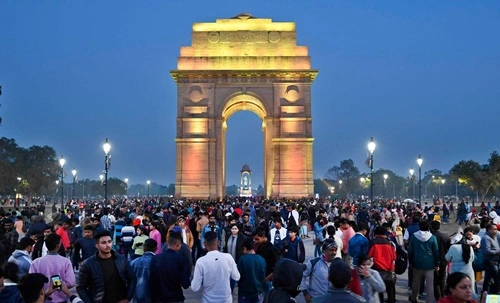As the world rings in 2025, a significant demographic milestone is set to be achieved: the global population is expected to reach an estimated 8.09 billion people on New Year’s Day. The United Nations projects this increase, marking a growth of approximately 22 million people compared to the same date in 2024. India, with its 1.4 billion residents, continues to hold the title of the most populous country, having surpassed China earlier in the year.
India Tops the Population Charts

India’s population surge has been a topic of global discussion, reflecting the nation’s economic growth, social challenges, and immense potential. With its younger demographic, India is poised to play a critical role in shaping the global economy and tackling pressing issues like climate change, poverty, and technological innovation.
The United Nations Population Fund (UNFPA) highlights that India’s demographic dividend, if leveraged effectively, could drive economic growth for decades. However, experts caution that addressing issues like healthcare, education, and employment is essential to harness this advantage.
Global Population Trends
The global population has seen rapid growth over the past century. In 1950, the world population was around 2.5 billion. Today, it stands over three times that figure. Factors such as improved healthcare, declining mortality rates, and advances in agriculture and technology have contributed to this increase.
Despite this growth, regional trends are diverging. Developed nations, particularly in Europe and East Asia, are experiencing declining birth rates and aging populations. In contrast, countries in sub-Saharan Africa and South Asia, including India, are witnessing rapid population growth. The UN predicts that much of the future population increase will be concentrated in a handful of nations, with India, Nigeria, and Pakistan leading the way.
The Challenges of Population Growth
As the global population expands, so do the challenges associated with it. Governments worldwide face the dual task of ensuring sustainable development while managing the pressures of population density, resource allocation, and environmental sustainability.
- Climate Change and Resource Scarcity:
A growing population places immense pressure on natural resources, including water, energy, and arable land. With climate change exacerbating these challenges, nations must adopt sustainable practices to ensure future generations’ survival and prosperity. - Urbanization and Infrastructure:
Rapid urbanization in populous nations like India has led to the growth of megacities, but also significant stress on housing, transportation, and public services. Effective urban planning is crucial to accommodate this growth. - Health and Education:
Ensuring access to quality healthcare and education for billions of people remains a significant hurdle, particularly in developing nations. These sectors are critical for empowering individuals and driving economic progress. - Aging Populations:
While some regions face population booms, others are grappling with aging societies. Countries like Japan and Italy must find innovative solutions to address workforce shortages and the increasing demand for eldercare.
India’s Role on the Global Stage
India’s emergence as the most populous nation underscores its growing influence in global affairs. With a median age of 28, India boasts one of the youngest populations in the world, presenting unique opportunities for economic and cultural leadership.
The Indian government has initiated various programs to address its population’s needs, from digital education initiatives to healthcare reforms like Ayushman Bharat. However, more investments in job creation, renewable energy, and climate resilience are essential to ensure long-term sustainability.
Prime Minister Narendra Modi, in his recent address, emphasized the importance of population control and family planning. “A responsible approach to family planning is vital for our nation’s future,” he said, urging citizens to contribute to India’s development responsibly.
Looking Ahead
As the world enters 2025 with a population exceeding 8.09 billion, the focus must shift from mere numbers to quality of life. Nations like India, leading the demographic charts, hold the key to global progress. By fostering innovation, promoting sustainable practices, and addressing social challenges, the world can ensure a brighter future for its ever-growing population.
The milestone serves as a reminder of humanity’s shared responsibility. The choices made today—whether in policies, technology, or social reforms—will shape the lives of billions for generations to come.

